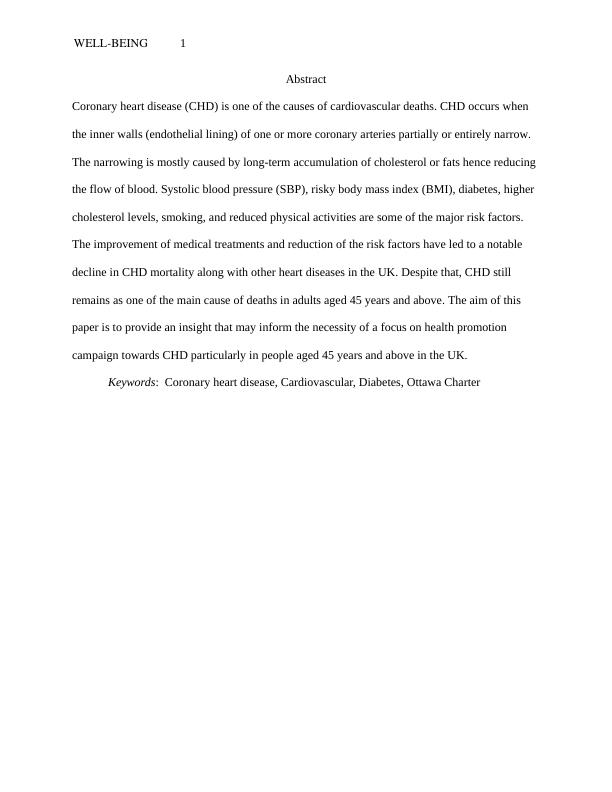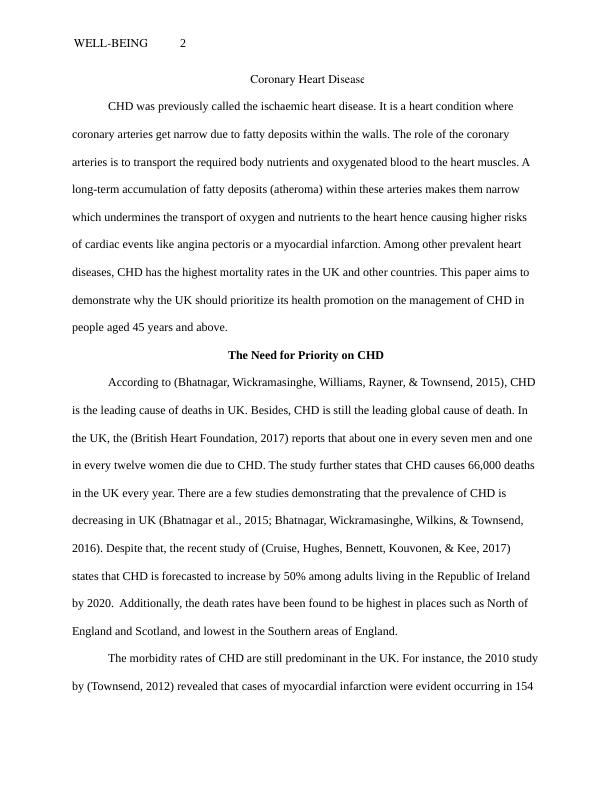National Health Priority in Coronary Heart Disease
Added on 2023-06-11
11 Pages3006 Words111 Views
Running head:
National Health Priority in Coronary Heart Disease
Author Name(s)
Institutional Affiliation(s)
Author Note
National Health Priority in Coronary Heart Disease
Author Name(s)
Institutional Affiliation(s)
Author Note

1
Abstract
Coronary heart disease (CHD) is one of the causes of cardiovascular deaths. CHD occurs when
the inner walls (endothelial lining) of one or more coronary arteries partially or entirely narrow.
The narrowing is mostly caused by long-term accumulation of cholesterol or fats hence reducing
the flow of blood. Systolic blood pressure (SBP), risky body mass index (BMI), diabetes, higher
cholesterol levels, smoking, and reduced physical activities are some of the major risk factors.
The improvement of medical treatments and reduction of the risk factors have led to a notable
decline in CHD mortality along with other heart diseases in the UK. Despite that, CHD still
remains as one of the main cause of deaths in adults aged 45 years and above. The aim of this
paper is to provide an insight that may inform the necessity of a focus on health promotion
campaign towards CHD particularly in people aged 45 years and above in the UK.
Keywords: Coronary heart disease, Cardiovascular, Diabetes, Ottawa Charter
Abstract
Coronary heart disease (CHD) is one of the causes of cardiovascular deaths. CHD occurs when
the inner walls (endothelial lining) of one or more coronary arteries partially or entirely narrow.
The narrowing is mostly caused by long-term accumulation of cholesterol or fats hence reducing
the flow of blood. Systolic blood pressure (SBP), risky body mass index (BMI), diabetes, higher
cholesterol levels, smoking, and reduced physical activities are some of the major risk factors.
The improvement of medical treatments and reduction of the risk factors have led to a notable
decline in CHD mortality along with other heart diseases in the UK. Despite that, CHD still
remains as one of the main cause of deaths in adults aged 45 years and above. The aim of this
paper is to provide an insight that may inform the necessity of a focus on health promotion
campaign towards CHD particularly in people aged 45 years and above in the UK.
Keywords: Coronary heart disease, Cardiovascular, Diabetes, Ottawa Charter

2
CHD was previously called the ischaemic heart disease. It is a heart condition where
coronary arteries get narrow due to fatty deposits within the walls. The role of the coronary
arteries is to transport the required body nutrients and oxygenated blood to the heart muscles. A
long-term accumulation of fatty deposits (atheroma) within these arteries makes them narrow
which undermines the transport of oxygen and nutrients to the heart hence causing higher risks
of cardiac events like angina pectoris or a myocardial infarction. Among other prevalent heart
diseases, CHD has the highest mortality rates in the UK and other countries. This paper aims to
demonstrate why the UK should prioritize its health promotion on the management of CHD in
people aged 45 years and above.
The Need for Priority on CHD
According to (Bhatnagar, Wickramasinghe, Williams, Rayner, & Townsend, 2015), CHD
is the leading cause of deaths in UK. Besides, CHD is still the leading global cause of death. In
the UK, the (British Heart Foundation, 2017) reports that about one in every seven men and one
in every twelve women die due to CHD. The study further states that CHD causes 66,000 deaths
in the UK every year. There are a few studies demonstrating that the prevalence of CHD is
decreasing in UK (Bhatnagar et al., 2015; Bhatnagar, Wickramasinghe, Wilkins, & Townsend,
2016). Despite that, the recent study of (Cruise, Hughes, Bennett, Kouvonen, & Kee, 2017)
states that CHD is forecasted to increase by 50% among adults living in the Republic of Ireland
by 2020. Additionally, the death rates have been found to be highest in places such as North of
England and Scotland, and lowest in the Southern areas of England.
The morbidity rates of CHD are still predominant in the UK. For instance, the 2010 study
by (Townsend, 2012) revealed that cases of myocardial infarction were evident occurring in 154
CHD was previously called the ischaemic heart disease. It is a heart condition where
coronary arteries get narrow due to fatty deposits within the walls. The role of the coronary
arteries is to transport the required body nutrients and oxygenated blood to the heart muscles. A
long-term accumulation of fatty deposits (atheroma) within these arteries makes them narrow
which undermines the transport of oxygen and nutrients to the heart hence causing higher risks
of cardiac events like angina pectoris or a myocardial infarction. Among other prevalent heart
diseases, CHD has the highest mortality rates in the UK and other countries. This paper aims to
demonstrate why the UK should prioritize its health promotion on the management of CHD in
people aged 45 years and above.
The Need for Priority on CHD
According to (Bhatnagar, Wickramasinghe, Williams, Rayner, & Townsend, 2015), CHD
is the leading cause of deaths in UK. Besides, CHD is still the leading global cause of death. In
the UK, the (British Heart Foundation, 2017) reports that about one in every seven men and one
in every twelve women die due to CHD. The study further states that CHD causes 66,000 deaths
in the UK every year. There are a few studies demonstrating that the prevalence of CHD is
decreasing in UK (Bhatnagar et al., 2015; Bhatnagar, Wickramasinghe, Wilkins, & Townsend,
2016). Despite that, the recent study of (Cruise, Hughes, Bennett, Kouvonen, & Kee, 2017)
states that CHD is forecasted to increase by 50% among adults living in the Republic of Ireland
by 2020. Additionally, the death rates have been found to be highest in places such as North of
England and Scotland, and lowest in the Southern areas of England.
The morbidity rates of CHD are still predominant in the UK. For instance, the 2010 study
by (Townsend, 2012) revealed that cases of myocardial infarction were evident occurring in 154

3
men and 34 women for every 100,000 men and women. In Scotland, 255 men and 113 women
had myocardial infarction out of every 100,000 men or women (Townsend, 2012). The
incidences of angina were occurring at 38 men and 21 women out of every 100,000 men or
women (Townsend, 2012). Although prevalence rates of CHD are falling, the effects and the
increasing number of survivors of CHD requires emphasis to counter the adverse impacts of
CHD (Townsend, 2012).
The risk factors for CHD
Smoking is counted as a major risk factor to CHD. According to (British Heart
Foundation, 2017), there is more than one person in every six adults who smoke cigarettes in the
UK, and this number adds up to more than 8 million adults in total. This study also states that
there are up to 20,000 deaths resulting from cardiovascular disease in the UK every year, and all
of them are related to smoking. Another risk factor is the High blood pressure (HBP). According
to (Olafiranye et al., 2011), hypertension heightens the development of atherosclerosis, and the
occurrence of HBP destabilizes the vascular lesions which lead to critical coronary events. High
levels of cholesterol in the blood are also said to be another risk factor. This risk was explained in
(Wilkins et al., 2014) that the higher the level of cholesterol in the blood causes an increase in
the risk of CHD as higher levels of cholesterol causes the narrowing of the arteries while a piece
of fat within the blood passage can cause blood clot hence leading to a heart attack.
Another risk factor for CHD is diabetes. According to (Ali, Narayan, & Tandon, 2010),
the type 2 diabetes mellitus is closely associated with CHD. Diabetes is shown to have two to
fourfold higher risk of causing CHD. The work of (Aronson & Edelman, 2014) explains this
concept further by stating that cardiovascular mortality across age groups and sexes increase at
the same rate with the increase of diabetes mellitus. Less physical activities (PA) also increase
men and 34 women for every 100,000 men and women. In Scotland, 255 men and 113 women
had myocardial infarction out of every 100,000 men or women (Townsend, 2012). The
incidences of angina were occurring at 38 men and 21 women out of every 100,000 men or
women (Townsend, 2012). Although prevalence rates of CHD are falling, the effects and the
increasing number of survivors of CHD requires emphasis to counter the adverse impacts of
CHD (Townsend, 2012).
The risk factors for CHD
Smoking is counted as a major risk factor to CHD. According to (British Heart
Foundation, 2017), there is more than one person in every six adults who smoke cigarettes in the
UK, and this number adds up to more than 8 million adults in total. This study also states that
there are up to 20,000 deaths resulting from cardiovascular disease in the UK every year, and all
of them are related to smoking. Another risk factor is the High blood pressure (HBP). According
to (Olafiranye et al., 2011), hypertension heightens the development of atherosclerosis, and the
occurrence of HBP destabilizes the vascular lesions which lead to critical coronary events. High
levels of cholesterol in the blood are also said to be another risk factor. This risk was explained in
(Wilkins et al., 2014) that the higher the level of cholesterol in the blood causes an increase in
the risk of CHD as higher levels of cholesterol causes the narrowing of the arteries while a piece
of fat within the blood passage can cause blood clot hence leading to a heart attack.
Another risk factor for CHD is diabetes. According to (Ali, Narayan, & Tandon, 2010),
the type 2 diabetes mellitus is closely associated with CHD. Diabetes is shown to have two to
fourfold higher risk of causing CHD. The work of (Aronson & Edelman, 2014) explains this
concept further by stating that cardiovascular mortality across age groups and sexes increase at
the same rate with the increase of diabetes mellitus. Less physical activities (PA) also increase

End of preview
Want to access all the pages? Upload your documents or become a member.
Related Documents
Research Paper on Epidemiology of Cardiovascular Diseaselg...
|12
|4182
|33
Coronary Heart Disease (CHD): Assignmentlg...
|23
|5462
|49
Assignment On Coronary Artery Diseaselg...
|4
|810
|26
Trevor Name of the University Author Note From Case Study Of Trevor Name of the University Authorlg...
|11
|3097
|292
Case Study of ST-Elevated Myocardial Infarctionlg...
|9
|3304
|1
Article on Coronary Heart Diseaselg...
|13
|4369
|79
